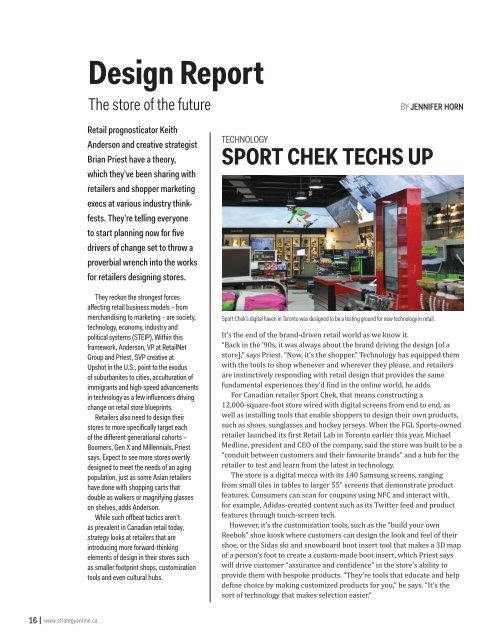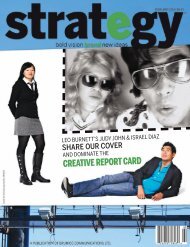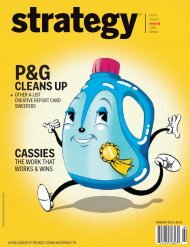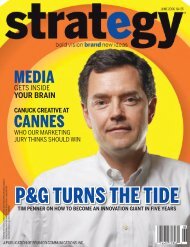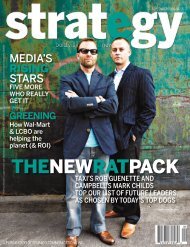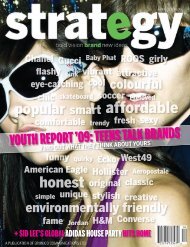download the PDF version - Strategy
download the PDF version - Strategy
download the PDF version - Strategy
Create successful ePaper yourself
Turn your PDF publications into a flip-book with our unique Google optimized e-Paper software.
Design Report<br />
The store of <strong>the</strong> future<br />
Retail prognosticator Keith<br />
Anderson and creative strategist<br />
Brian Priest have a <strong>the</strong>ory,<br />
which <strong>the</strong>y’ve been sharing with<br />
retailers and shopper marketing<br />
execs at various industry thinkfests.<br />
They’re telling everyone<br />
to start planning now for five<br />
drivers of change set to throw a<br />
proverbial wrench into <strong>the</strong> works<br />
for retailers designing stores.<br />
They reckon <strong>the</strong> strongest forces<br />
affecting retail business models – from<br />
merchandising to marketing – are society,<br />
technology, economy, industry and<br />
political systems (STEIP). Within this<br />
framework, Anderson, VP at RetailNet<br />
Group and Priest, SVP creative at<br />
Upshot in <strong>the</strong> U.S., point to <strong>the</strong> exodus<br />
of suburbanites to cities, acculturation of<br />
immigrants and high-speed advancements<br />
in technology as a few influencers driving<br />
change on retail store blueprints.<br />
Retailers also need to design <strong>the</strong>ir<br />
stores to more specifically target each<br />
of <strong>the</strong> different generational cohorts –<br />
Boomers, Gen X and Millennials, Priest<br />
says. Expect to see more stores overtly<br />
designed to meet <strong>the</strong> needs of an aging<br />
population, just as some Asian retailers<br />
have done with shopping carts that<br />
double as walkers or magnifying glasses<br />
on shelves, adds Anderson.<br />
While such offbeat tactics aren’t<br />
as prevalent in Canadian retail today,<br />
strategy looks at retailers that are<br />
introducing more forward-thinking<br />
elements of design in <strong>the</strong>ir stores such<br />
as smaller footprint shops, customization<br />
tools and even cultural hubs.<br />
BY JENNIFER HORN<br />
TECHNOLOGY<br />
SPORT CHEK TECHS UP<br />
Sport Chek’s digital haven in Toronto was designed to be a testing ground for new technology in retail.<br />
It’s <strong>the</strong> end of <strong>the</strong> brand-driven retail world as we know it.<br />
“Back in <strong>the</strong> ’90s, it was always about <strong>the</strong> brand driving <strong>the</strong> design [of a<br />
store],” says Priest. “Now, it’s <strong>the</strong> shopper.” Technology has equipped <strong>the</strong>m<br />
with <strong>the</strong> tools to shop whenever and wherever <strong>the</strong>y please, and retailers<br />
are instinctively responding with retail design that provides <strong>the</strong> same<br />
fundamental experiences <strong>the</strong>y’d ind in <strong>the</strong> online world, he adds.<br />
For Canadian retailer Sport Chek, that means constructing a<br />
12,000-square-foot store wired with digital screens from end to end, as<br />
well as installing tools that enable shoppers to design <strong>the</strong>ir own products,<br />
such as shoes, sunglasses and hockey jerseys. When <strong>the</strong> FGL Sports-owned<br />
retailer launched its irst Retail Lab in Toronto earlier this year, Michael<br />
Medline, president and CEO of <strong>the</strong> company, said <strong>the</strong> store was built to be a<br />
“conduit between customers and <strong>the</strong>ir favourite brands” and a hub for <strong>the</strong><br />
retailer to test and learn from <strong>the</strong> latest in technology.<br />
The store is a digital mecca with its 140 Samsung screens, ranging<br />
from small tiles in tables to larger 55” screens that demonstrate product<br />
features. Consumers can scan for coupons using NFC and interact with,<br />
for example, Adidas-created content such as its Twitter feed and product<br />
features through touch-screen tech.<br />
However, it’s <strong>the</strong> customization tools, such as <strong>the</strong> “build your own<br />
Reebok” shoe kiosk where customers can design <strong>the</strong> look and feel of <strong>the</strong>ir<br />
shoe, or <strong>the</strong> Sidas ski and snowboard boot insert tool that makes a 3D map<br />
of a person’s foot to create a custom-made boot insert, which Priest says<br />
will drive customer “assurance and conidence” in <strong>the</strong> store’s ability to<br />
provide <strong>the</strong>m with bespoke products. “They’re tools that educate and help<br />
deine choice by making customized products for you,” he says. “It’s <strong>the</strong><br />
sort of technology that makes selection easier.”<br />
16 www.strategyonline.ca


